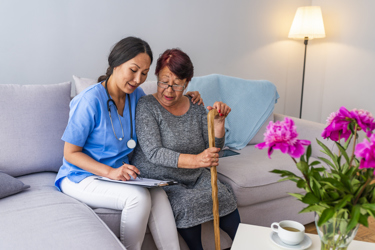Making Care At Home Possible
By Adam Mahmud, Jamf

Care-at-home as a concept is not new. In the early 1900s, doctors would often make home visits for patients. Today, as healthcare costs continue to skyrocket, hospitals are increasingly trying to figure out how to send patients home as early as possible after a procedure or illness.
Benefits Of Care At Home
But providing care at home is not merely a cost-containment measure. Multiple studies show that for many conditions, patients recover faster and are less likely to contract infection when recovering at home. Patients prefer it, as well: better sleep, familiar conditions and increased connection with loved ones makes recovery more pleasant and sometimes faster.
Despite these many benefits making care-at-home seem like a no-brainer, it’s not as simple as it seems. In many cases, hospitals are leery of this approach because they are concerned about not being able to monitor patients closely. With very ill patients, such as premature babies or ones with heart defects, doctors don't want to depend on only a daily visit from a nurse or a doctor's visit to monitor. Because of how high stakes these patients are, hospitals often just keep them admitted.
The Technology That Makes It A Reality
It is now possible to bridge the gap between hospital and home - with vital real-time monitoring that is allowing patients to benefit from healing at home without incurring unnecessary risk. There are several new mobile applications that offer secure communication and data transfer between patients, families and care teams. For example, a new mother can easily send in key vitals of her newborn, which are immediately available for her provider to review. Thanks to mobile device management, tablets can be automatically configured with the right apps, settings, restrictions that each health system needs. This easy user experience is a quick way to drive adoption of the platform, which supports the overarching vision: a better clinical outcome and overall patient experience.
Locus Health, one application making care at home a reality today, sends patients home with a dedicated and managed iPad, which allows them to communicate in real-time with providers: doing their own monitoring and reporting at home on the iPad, and providers have the information instantly. One feature is even programmed to offer specific instructions based on data, as well as request the patient call the hospital – with a phone number they can simply select to dial – when input shows cause for concern.
Patients can make use of information, as well: they receive test results immediately, can access staff to ask questions, and receive instructions on care based on test results. This also has the effect of increasing compliance among patients sent home and reducing the need for office visits as clinician networks and patients communicate through the iPad.
Dr. Jeff Vergales, a pediatric cardiologist at the University of Virginia, says that it increases patient confidence, as well.
“It’s amazing to see the reassurance that comes when we can send families home with a solution that allows them to stay engaged with us from day one,” says Vergales.
What Is The Long-Term Potential Of At-Home Care Tech?
A few systems are already experimenting with blue tooth-enabled sensors attached to continuous glucose monitors and insulin pumps that can automatically and instantly send data to a healthcare provider without patients needing to do a thing. This data automatically uploads to Apple Health, which can help synthesize data for patients and clinicians, sharing it – again – in real time.
There is so much potential, especially with scalable managed solutions, to increase general population health using individual's own devices and leveraging Apple Health or other programs, tracking and monitoring patient exercise, nutrition, and vitals as well as offering tailored personalized suggestions such as flu vaccination reminders.
While the potential for individually owned devices is exciting, it's important to keep in mind that many patients, especially those experiencing poverty, don't have access to cutting-edge technology. For equity and better healthcare for all, hospitals and clinics who want to benefit from these advances should always have a managed device on hand to serve all of their patients with excellent care.
About The Author
Adam Mahmud is Healthcare Lead at Jamf.
